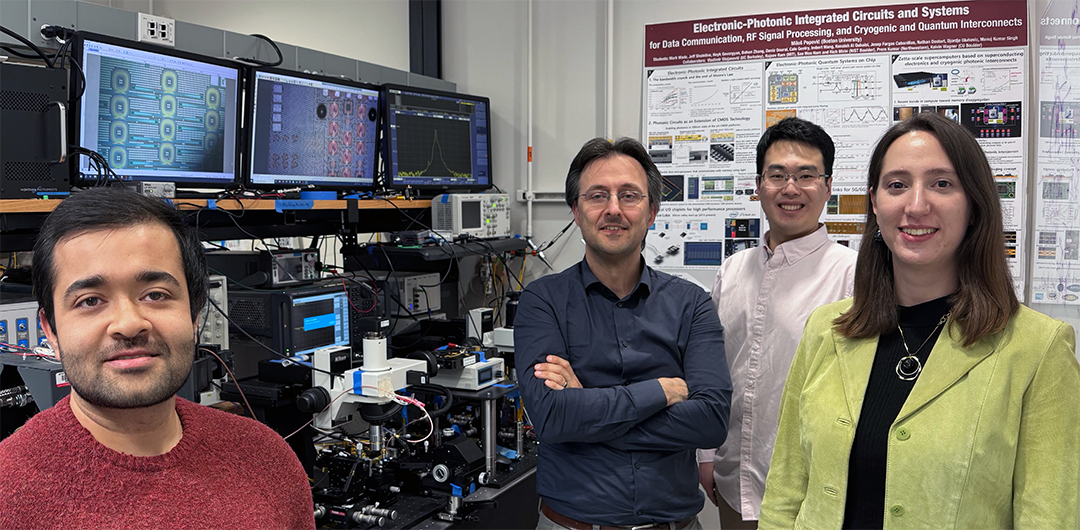ECE CHIPS In: The Computing Power of Light

This is the second article in our series highlighting BU ECE’s contributions to research and education under the umbrella of the CHIPS and Science Act of 2022, and our faculty’s collective investment in the national effort to build a robust and innovative semiconductor industry.
by A.J. Kleber
The urgency of our society’s insatiable appetite for more data processing power lies at the heart of much of today’s cutting-edge research, as accelerating breakthroughs in technologies like AI and AR/VR race the development of the underlying systems that can support their increasingly steep requirements for processing power. Under the auspices of a $470K NSF Future of Semiconductors (FuSe) grant, Professor Miloš Popović intends to shine a light on one potential solution.
In collaboration with researchers from UC Berkeley and UCLA, Professor Popović and his research group plan to utilize his specialty, electronic-photonic integrated circuits, to develop new technologies for next-generation wireless services. The approach of their project, titled CODAeMIMO (“Collaborative Optically Disaggregated Arrays of Extreme-MIMO Radio Units”), will combine a number of techniques to free up resources, alleviate capacity problems, and maintain signal quality – all enabled by Popović’s light-enabled microchips, or EPSoCs (for “Electronic-Photonic Systems-on-Chip”).

“Light is the right medium for communication,” says Popović, and he should know. The professor has been pioneering developments in the monolithic integration of electronic circuits and optical devices–combining these different technologies onto a single tiny silicon chip–for over fifteen years. In 2015, his team and collaborators demonstrated the world’s first microprocessor with “optical I/O” (i.e. communication with other chips via light). In the same year, with his collaborators and former graduate students, he co-founded Ayar Labs, now an industry thought leader in chip-to-chip optical communication, dedicated to bringing academic research into the commercial sector. Through partnerships with leading companies like GlobalFoundries and Intel, Ayar Labs has been instrumental in the development of commercially viable platforms for fabricating integrated photonic devices and circuits, and continuing to drive research into the broad potential applications of the technology. Recently, a joint Ayar Labs/Intel project, the first optically-enabled commercial FPGA processor, was demonstrated at the White House at the “American Possibilities Demo Day” on November 7 of this year.
Not only will Popović’s group’s technology for EPSoCs be central to the CODAeMIMO team’s effort, but so will the BU students he mentors. The BU research team is led by current PhD students Manuj Singh and Deniz Onural, in collaboration with UC Berkeley peers. The “photonic molecule” modulator which is a core piece of the CODAeMIMO technology stack was developed as part of Popović lab alumnus Hayk Gevorgyan’s (PhD’21) award-winning dissertation research. Alongside the development of innovative new technologies, a key goal of the project is the fostering of a “unique crop” of up-and-coming young engineers and scientists with a foundation in collaborative, boundary-crossing transdisciplinary research– in other words, the vital future workforce needed to address the looming challenges facing our society.
Popović has a long track record of energizing and involving students in his cutting-edge research; one of his early doctoral mentees, Mark Wade, recently took over the reins as CEO of Ayar Labs, which he also co-founded. And the opportunities for mentorship certainly aren’t limited to graduate students. When undergraduate Winston Liu took Popović’s first-year circuits course, his professor noticed his ingenuity and recruited him. “He’s building rockets in his dad’s garage,” the professor recalls thinking. “I should get him doing something safer.” Supported by a summer NSF REU (“Research Experiences for Undergraduates”) supplemental grant, Liu has recently had the opportunity to include his own component design on a test chip sent by the group for fabrication. All things considered, it’s not surprising that Popović received not one but two Supervisor of the Year Awards in 2022, from Boston University, and the Northeast Association of Student Employment Administrators (NEASEA); both competitive, student-nominated honors.
Nor is it surprising that CODAeMIMO fits into the criteria for the NSF FuSe program, with its emphasis on public-private partnership, rapid technological progress, and workforce development; criteria which in turn echo the goals of the CHIPS and Science Act of 2022. Ultimately, Popović and his dedicated colleagues aim to dramatically improve communications and sensing technologies while continuing to develop tools and resources to make photonic-integrated design more broadly accessible. Perhaps most importantly, they will send a new generation of young researchers and innovators out into the world to build on these successes; scientists and engineers experienced in the full range of technological development, from fundamental physics to practical applications for their designs.
Professor Miloš Popović joined BU ECE in 2016, and holds a doctoral degree from MIT. He is a 2012 Fellow of the Packard Foundation, a select group of the nation’s top innovators, and was elected a Fellow of the National Academy of Inventors (NAI) in 2023. While on sabbatical from his teaching duties in 2023-2024, he is serving as Senior Technical Architect at Ayar Labs.

